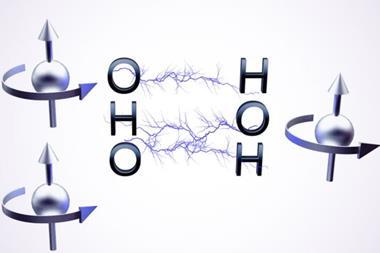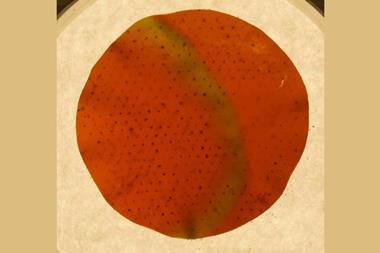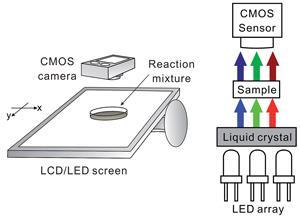Scientists in the UK have tackled optimisation problems currently targeted by quantum computers using the pulsating Belousov-Zhabotinsky (BZ) reaction. Lee Cronin’s University of Glasgow team uses colour oscillations in interconnected wells to encode data. ‘If a chemical computer can beat a quantum computer in message decryption, that would be hilarious,’ Cronin tells Chemistry World. However, experts are still sceptical that such a feat is possible.
Many unconventional computers use BZ colour changes. The Glasgow team’s are two 3D-printed arrays of interconnected wells. One is a single row containing seven such wells, the other a full 7x7 cellular grid. Each well has a narrow gap in each wall, with partial wells abutting the walls around the array’s outside. At these walls, pipes supply chemicals needed for BZ reactions. Wells fluctuate between red and blue colours, as sulfuric and malonic acid interact with ferroin indicator and potassium bromate.
The researchers put magnetic stirrer bars centrally in each well and each gap. They control each stirrer individually using nearby magnets attached to separate motors. For a BZ oscillation to happen, the central stirrer must be on.
The gaps improve on the group’s previous design, in which reagents didn’t flow controllably between wells. Turning stirrers on in the gaps drives that flow, synchronising the BZ reaction’s colour changes, which normally drift out of time. Unlike the digital computers we know best, the BZ computers use finite state logic, as the wells exist only in a limited number of states.
Chemically emergent computers
The Glasgow team represents an initial state in the array as BZ pulses, changing between blue, light blue and red. They use a kind of artificial intelligence (AI) to classify the state. The AI then controls digital inputs to the stirrers about what pulse state should appear next and addition of reagents. However, the researchers argue that the AI is not exclusively determining the pulse state. Instead, chemical interactions can contribute to the new state forming.
Cronin’s team uses its BZ computers to demonstrate cellular automata, which are among the best-known applications of state machines. The state of a cellular automaton evolves over time according to specific rules, perhaps most famously in the Game of Life.
In the BZ computer cellular automata should see patterns of pulses evolve in a specific order. Turning stirrers in the gaps between cells off when they’re not synchronising pulses ensures the computer exactly follows this sequence. Leaving the stirrers in the gaps on, however, produces novel ‘emergent’ patterns as chemical information flows between and is stored within cells. The Glasgow chemists sought to use emergent behaviour to solve mathematical problems using quadratic unconstrained binary optimisation, which is currently targeted by quantum computers.
Theodore Gray, chemistry author and co-founder of Wolfram Research, whose Mathematica software includes commands that produce cellular automata, speaking in a personal capacity to Chemistry World, questions the approach’s potential. ‘I’m sure it works as described but is there really a path by which this technique can end up faster or cheaper than silicon chips?’ he asks. He also doubts it can really tackle optimisation problems faster than quantum computers.
Ben de Lacy Costello from the University of West of England likewise notes that ‘there are lots of different approaches’ to exploiting BZ computers. ‘This maybe is just another one of those,’ de Lacy Costello comments. However, he is impressed by the engineering involved.
Cronin’s team is now writing a compiler that exploits the BZ reaction for general-purpose computing. He admits it will be slower on some problems than other computers. However, it should use much less energy and could be faster for optimisation problems. ‘It’s very easy to encode the optimisation,’ he says.
References
A Sharma et al, Nat. Commun., 2024, 15, 2421 (DOI: 10.1038/s41467-024-46859-8)

















No comments yet